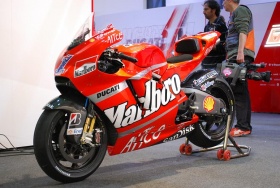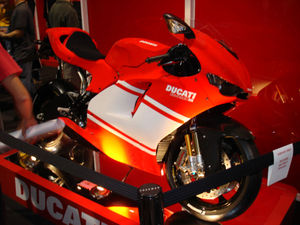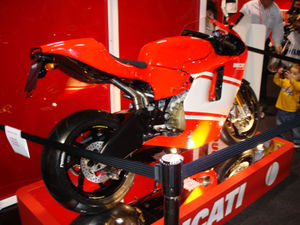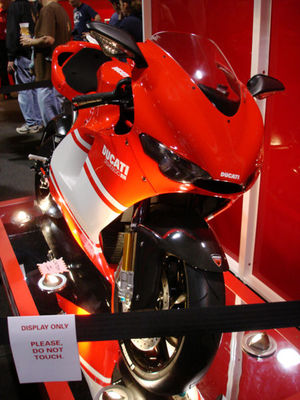Ducati Desmosedici

| |
| Ducati Desmosedici | |
|---|---|
| Aka | Ducati D16 |
| Manufacturer | Ducati |
| Production | 2003-present |
| Similar | Aprilia RS3 Cube Honda RC212V Kawasaki Ninja ZX-RR Team Roberts KR211V Suzuki GSV-R Yamaha YZR-M1 Ilmor X3 |
Ducati Desmosedici is the name of the series of 4-Stroke V4 Prototype Motorcycles developed by Ducati to compete in the MotoGP World Championship. GPx indicates the version of the bike, where x corresponds to the year the bike raced (ie the Desmosedici GP9 raced in 2009).
For one time, limited production, Ducati made 1500 Desmosedici's racing replica called Desmosedici RR for public worldwide. The bike was eventually launched at the 2006 Italian MotoGP event and Ducati guaranteed customer orders will be fulfilled by the end of 2008. The entire 500 units for the United States sold out in five hours.
Background
Ducati abandoned the Grand Prix racing scene at the start of the 1970s. For many years the 500 class was essentially a class for two-stroke bikes, an engineering technology that was far removed from the four-stroke road-going machines sold by Ducati. Technical rules changed in 2002, giving priority to four-stroke machinery and turning the 500 class of World Road Racing into the MotoGP Championship. This convinced Ducati to make a much-awaited return to the track in the new MotoGP class.
Ducati history is classically based on L-twin engines, using desmodromic valve technology. Initially, Ducati considered the possibility of creating a MotoGP ‘super-twin’, taking advantage of the MotoGP regulations that give twin-cylinder machines a considerable weight reduction over four, five or six-cylinder bikes. However, analysis indicated that a twin-cylinder engine would not have been able to produce the required amount of power (more than 230 hp), without excessively increasing the number of revs. A Twin would have had to rev at over 17,000 rpm, but this would require a very short stroke and a very large bore, as a result producing possible combustion problems.
The basis of the design of the Desmosedici engine therefore is two classical Ducati L-Twins next to each other, making a Double L Twin with 2 cylinder Stroking at the same time (also called Twin Pulse). With four valves per cylinder, the total number of valves is sixteen - Desmosedici means desmodromic distribution with sixteen valves shortened in Italian
Design had started in 2001, the bike was unveiled at the 2002 Italian GP at Mugello, for use in the following seasons MotoGP World Championship. Vittoriano Guareschi, the Ducati Corse test-rider, followed every phase of the Desmosedici’s development process from early testing to track debut and the project’s evolution. In 2007, Ducati's pilot Casey Stoner, riding a Desmosedici, obtained Ducati's first MotoGP World Championship Title.
GP3
While still fully committed to Superbike racing, the Ducati Marlboro Team of Loris Capirossi and Troy Bayliss would compete in all rounds of the 2003 MotoGP championship. The Desmosedici GP3 quickly scored a series of results with Loris Capirossi, who stepped onto the podium in the opening round of the championship in Japan and won the GP Catalunya in Barcelona. Riders Capirossi finished fourth in the final championship standings and Bayliss sixth; while Ducati finished second overall in the Manufacturers’ standings
GP4
In 2004 the Desmosedici GP4, again in the hands of Capirossi and Bayliss, underwent a series of major modifications. A large part of the season went by before the bike became competitive, but the season concluded with both riders on the podium.
At 989 cc, the GP4's top speed record of 347.4km/h was set by Loris Capirossi on at IRTA Tests in Catalunya, Spain.
GP5
Template:Double image stack The GP5 version lined up for Ducati’s third season in MotoGP, with Bayliss replaced by the Spanish rider Carlos Checa. Thanks to a collaboration agreement with Bridgestone, Ducati could finally contribute to the development of new tires and by the end of the season the Desmosedici become a competitive machine. Bridgstone found that hard tires suited the bike more than softer tires to create grip - simply put, allowing it to spin the rear wheel gave better control. Capirossi took two wins in the Grand Prix of Japan at Motegi and in the Malaysian GP at Sepang, while Checa scored a brace of podium finishes
GP6
Launched at the Italian skiing resort of Madonna di Campiglio, the GP6 is a lighter and more powerful version of the GP5. Involving better aerodynamics and a better fuel tank position, most importantly, although more powerful, the engine delivery was smoothed to make the bike more ridable. This made the bike slower on top speed, but quicker into, around and out of corners.
The new rider with Capirossi was Spanish rider Sete Gibernau. After encouraging winter tests, the Desmosedici GP6 took its first win of 2006 in the opening GP at Jerez de la Frontera, Spain, followed by a podium in Qatar. Capirossi led the championship for a short while, but at the start of the Grand prix de Catalunya at Barcelona, Gibernau's bike collided with Capirossi's after Gibernau braked too late and compressed his brake lever ferther after impacting it on the back of Capirossi's bike. Both riders ended up injured and in the hospital, with Gibernau sustaining a broken collar bone, and both missed the Dutch Grand Prix at Assen. Capirossi returned at the British Grand Prix, while Gibernau was replaced by German Alex Hofmann for the Dutch Grand Prix, the British Grand Prix, and also the Czech Grand Prix after undergoing additional surgery. With Gibernau sidelined for the final round of the season at Valencia following a collision with Casey Stoner, Ducati recalled Bayliss, who was recently crowned World Superbike champion. The race was won by Bayliss, his first MotoGP victory, with Capirossi taking second place for the first Ducati 1-2 finish.
GP7
For 2007, MotoGP rules were changed to cap motors to a maximum displacement of 800 cc. In response, Ducati built the GP7. Its specifications were: 800 cc bike, double L-Twin motor (4 Cylinder Twin Pulse), approximately 168kW at 19'000 RPM and a 330+ km/h top speed (Confirmed 337.2 km/h (209.6 mph).
Ducati started its project to build an 800 cc MotoGP bike extremely early and according to Ducati's racing chief Filippo Preziosi, by August 2006 Ducati had already built 20 800 cc engines with various specifications. In addition, an early version of the bike was track tested for the first time during early May 2006. Public testing with the bike began at the Brno Track, where Loris Capirossi had won the day before riding the GP6, on the 21st of August. Capirossi's lap times on the prototype GP7 were only 1.4 seconds off his track record time set on the 990 cc GP6.
Further testing of the GP7 in Motegi, Japan, revealed that the 800 cc machine could run faster laps than the higher-displacement 990 cc bikes, and held nearly a second advantage over the next fastest 800 cc bike, a Honda ridden by Dani Pedrosa.
It was noted in Motosprint that as of the Le Mans Grand Prix the GP7 had a 20hp advantage over Honda and Yamaha MotoGP bikes. This horsepower advantage gave it a significant speed advantage through the early part of the season. The bike was rumored to have aerodynamic settings that could be changed to increase top speed if needed.
MotoGP's 800 cc era officially began with the first race of the 2007 MotoGP season, at the Losail International Circuit in Qatar. Casey Stoner won the race on the new GP7. The bike had a clear top speed advantage over the rest of the grid, due to its higher output motor. A new track record was set on the GP7. Second place contender and five time former World champion, Yamaha's Valentino Rossi, testified that "unfortunately, there was too much difference between (our) bikes in the straight" and "Our Yamaha will never go as quick on a straight as the Ducati." These words turned out to be true, as the GP7 enjoyed a top speed advantage throughout the season, although the other manufacturers (Yamaha, Honda, Kawasaki and Suzuki) closed the gap significantly by the end of the year. Stoner and his Bridgestone-shod Ducati proved to be the top combination in MotoGP and he won the world championship at Motegi, Japan, on September 23 2007, four races before the end of the season.
GP8
An evolutionary update of the GP7 design, Ducati's entry for the 2008 MotoGP World Championship was tested first in February 2007.
For purposes of avoiding chatter which was encountered on some occasions with GP7, the rigidity of the GP8's frame was altered, although further details of relevant modifications are not disclosed. In addition, in an attempt to reduce an effect described as "pumping", some modifications to the bike's suspension geometry were made.
As with its predecessor the GP8 contains a 4-cylinder 800cc engine with desmodromic actuation of its 16 valves. The engine has improved mid-range response and top-end power compared to that of the GP7.
During 2007 Ducati tested a special fuel saving clutch arrangement which disengaged the clutch during braking and reduced fuel consumption, however the arrangement was not incorporated in the GP8 as various advanced lubricants and fuels used with the GP8 are believed to provide comparable fuel savings, while decreasing internal engine friction and increasing maximum power.
In race trim the bike recorded an official top speed of 343.2km/h at the 2008 Chinese motorcycle Grand Prix. However, in a video of the same race, Casey Stoner is seen to ride the bike at the speed of 347km/h.
GP9
Has been testing on track since May 2008 and its Ducati's entry for the 2009 MotoGP World Championship. On 9 June 2008, Ducati publicly rolled out the Desmosedici GP9 for testing at Circuit de Catalunya.
A distinctive feature of GP9 is its carbon fibre chassis, representing a departure from Ducati's traditional steel trellis chassis. Although carbon fibre chassis were tried in mid 1980s, currently no other MotoGP racing team uses them.
| Ducati Desmosedici GP9 (2009) Specifications | |
|---|---|
| Engine | |
| Engine type: | Liquid-cooled, 90-degree, V4 4-stroke with 16-valve, Desmodromic DOHC |
| Displacement: | 799 cc |
| Ignition: | Magneti Marelli |
| Fuel System: | Fuel injection |
| Lubrication system: | Shell Racing V-Power |
| Carburation | Indirect Magneti Marelli electronic injection, four throttle bodies with injectors above butterfly valves. Throttles operated by EVO TCF (Throttle control & Feedback) system |
| Maximum power: | Approximately (170 kW) 230 bhp |
| Maximum speed: | Approximately 350 km/h (in excess of 215 mp/h) |
| Transmission | |
| Type: | 6-speed cassette-type gearbox, with alternative gear ratios available |
| Primary drive: | Gear |
| Clutch: | Dry multi-plate slipper clutch |
| Final drive: | Chain |
| Chassis and running gear | |
| Frame type: | Carbon fiber chassis, pressed aluminium swing-arm |
| Front suspension: | Ohlins upside-down 42mm front forks |
| Rear suspension: | Ohlins rear shock absorber, adjuster for pre-load, compression and rebound damping |
| Front/rear wheels: | 16.5" front and rear |
| Front/rear tyres: | Bridgestone |
| Front brake: | Brembo, two 320mm carbon front discs with four-piston callipers |
| Rear Brake: | Brembo, single stainless steel rear disc with two-piston callipers |
| Weight: | 148 kg or 326 lb |
| Fuel capacity: | 21 litres or 5.5 gallons |
Desmosedici RR (Racing Replica)
In 2004, Ducati announced that they would be producing a low volume bespoke replica of the Desmosedici, available from 2006.
Termed the Desmosedici RR (Racing Replica), it was claimed to be the first true road replica of a MotoGP racing bike. Priority for ordering was given to Ducati 999R owners, with production projected at one bike per day at a retail cost of $72,500 and GBP 40,000. The price includes a three year warranty and servicing, cover plus a racing kit including a "race only" exhaust system, a "slip-on" muffler and complimentary fuel and ignition mapping in a "race ECU". Production has been limited to 1500 motorcycles. It also includes Sponsor Stickers, enough to fill both sides of the bike.
The bike was eventually launched at the 2006 Italian MotoGP event at Mugello, with production beginning in December 2007 and the first customer orders delivered from January 2008. Ducati guaranteed customer orders will be fulfilled by the end of 2008. The entire allocation for the United States sold out in five hours.
| Ducati Desmosedici RR |
|---|
Specifications
- Engine
- Type: Double L-Twin (4 cylinder Twin Pulse), liquid-cooled, DOHC, Desmodromic, four valves per cylinder, gear-driven camshafts
- Displacement: 989cc
- Power: 147.1kW @ 13,800 rpm
- Torque: 11.8kgm @ 10,500 rpm
- Fuel injection: Four 50mm Magneti Marelli throttle bodies, 12-hole "microjet" with injectors over throttle, manual idle control
- Exhaust: '4-into-2-into-1' vertical exit exhaust/silencer
- Emissions: Euro 3
- Transmission
- Gearbox: 6-speed; Cassette type
- Clutch: Dry multi-plate slipper clutch, hydraulically actuated
- Vehicle
- Body: Full carbon fiber bodywork
- Frame: Tubular steel trellis hybrid, carbon fiber seat support, aluminum swingarm
- Front Suspension: Öhlins 'FG353' PFF forks USD 43mm pressurized, with preload, rebound and compression adjustment, TiN coated sliders
- Front Wheel: Marchesini forged and machined magnesium alloy wheels, with 7 spoke design as GP6
- Rear Suspension: Öhlins rear shock, with rebound, low/high speed compression adjustment, and hydraulic preload adjustment
- Rear Wheel: Marchesini forged and machined magnesium alloy wheels, with 7 spoke design as GP6
- Tires: Bridgestone, front 120/70 R17- rear 200/55 R16
- Front Brake: Two Brembo radial "monoblock" calipers with four 34mm pistons; two semi-floating 320mm x 6mm discs, with machined flange: the same as GP6 wet race set-up
- Rear Brake: 240mm fixed disc, fixed caliper with two 34mm pistons
- Fuel tank: aluminum alloy
- Dry Weight: 171kg
- Instruments: New lightweight Corse electronic multifunction dashboard with LCD 'bar' graph tachometer, trip/odometer, anti-theft immobilizer, lap time measurement, oil pressure, fuel reserve, EOBD, clock, air temperature, rev counter
- Version
- Colors: Two versions — 1) Desmosedici RR: Rosso GP with a white number plate on the tail section; 2) Desmosedici RR "Team Version": Rosso GP with broad white fairing stripe.
- Versions: Single-seat with racing exhaust (102 dB) - without catalytic converter. A team sponsor decal kit will be provided with each bike.
External links
- Ducati.GP - Desmosedici Owner Blog
- Ducati Desmosedici RR's on the race track at Misano - Pictures and report from first public appearance at World Ducati Week 2007
- Ducati Desmosedici RR info, pictures and soundbite
- Ducati.com - The official manufacturer's website. Current model info, including online information, history, manuals and race team info


- Ducati GP6 Racing - official site for the Desmosedici GP6 race bike with team info
- Ducati Desmosedici RR - official site for the Ducati Desmosedici RR


- Desmosedici FAQ
- robotpig.net - Desmosedici RR - article about Desmosedici RR
- World's First Desmosedici RR goes to Tom Cruise
| Grand Prix Motorcycles, 2000-2009 | |||||||||||
| Series | Manufacturer | 2000s | |||||||||
| 0 | 1 | 2 | 3 | 4 | 5 | 6 | 7 | 8 | 9 | ||
| MotoGP 500 cc 990 cc 800 cc |
Aprilia | RS3 Cube | |||||||||
| Ducati | Desmosedici GP3/GP4/GP5/GP6 | GP7/GP8 | |||||||||
| Honda | NSR500 | RC211V | RC212V | ||||||||
| Ilmor | X3 | ||||||||||
| Kawasaki | ZX-RR | ZX-RR | |||||||||
| Suzuki | RGV500 | GSV-R | GSV-R800 | ||||||||
| Team Roberts | Proton KR3 | Proton V5 | KR211V | KR212V | |||||||
| Yamaha | YZR500 | YZR-M1 | YZR-M1 | ||||||||
| 250 cc | Aprilia | RSW 250 GP | |||||||||
| Gilera | |||||||||||
| Honda | RS250RW | ||||||||||
| KTM | 250 FRR | ||||||||||
| Yamaha | |||||||||||
| 125 cc | |||||||||||
| Scrambler 250 | M620 Monster | 620 SPORT | 748 | 748S | 749 | 749/R/S | 750 Imola | 750 SS | 800 Sport | 800 SS | 848 | 851 | 888 Superbike | 900SS | 900GTS | 916 | 996 | 998 | 999 | 999/R/S | 1098 | 1198 | Apollo | Desmosedici | Hypermotard | Monster | Multistrada | Pantah | Paso | Sport 1000 Classic | 1000DS | PaulSmart1000LE | ST2 | ST3 | ST4 | ST4S | SuperSport | |
| Current motorcycles: | Multistrada (Multistrada 1200) · Desmosedici · Desmosedici RR · Monster 696 · Monster · SportClassic · 848 · 1098 · 1198 · Hypermotard · Streetfighter | |
|---|---|---|
| Previous motorcycles: | 60, 60S, 65S · 65T, 65TL, 65TS · 98, 98N, 98T, 98TL, 98S, 98SS · 125 S, SV · 125 Gran Sport Mariana · 125 Aurea · 98TS and 85, 98, 125 Bronco · Mach 1 · Apollo · 750 GT ·750 Imola · Supermono · 800SS · 851 · 888 · 900GTS · 748 · 749 · 916 · 996 · 998 · 999 · Pantah · Paso · PaulSmart1000LE · ST series (ST2 · ST3 · ST4) · SuperSport | |
| Ducati mopeds: | Cucciolo · 55 · Brisk · Falcon · Rolly | |
| Designers | Fabbro · Galluzzi · Taglioni · Tamburini · Terblanche | |
| Racing division: | Ducati Corse | |


